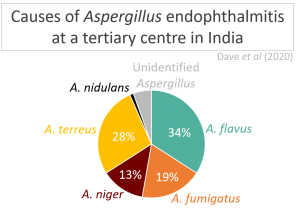Submitted by Aspergillus Administrator on 10 April 2012
 |
| Propolis in a hive |
Aspergillus is frequently found in bee hives along with several other fungal genus’. Some of those fungi are known to be pathogens of the bee, some in cooperation with virus’ that have been suspected of causing the recent collapse of honey bee numbers in many countries of the world (Colony Collapse Disorder). Some fungi (Ascosphaera – a close relative of Aspergillus) seem to exist only in association with honey bees and can also cause disease in the bee hive (Chalkbrood) – so how do bees prevent infection wiping out a hive?
A recent paper gives us a clue. Some plants secrete substances that have an antifungal activity and bees collect these substances to form a waxy chemical called Propolis. They line their hives with this substance – so do they do this to ward off infection? The authors of the paper show that the bees collect more Propolis when the hive is infected with Ascophaera and remove mouldy objects from the hive more frequently – they are actively controlling the extent of fungal infection. Furthermore they didn’t do this when infected with a non-pathogenic strain of fungus so this activity seems to be in response to fungi that are capable of causing them harm.
This information is economically useful. Bee keepers traditionally cultivate hives that are low in Propolis, so perhaps here we have a way to help keepers reduce fungal infection of their hives, and thus reduce the effect of Colony Collapse Disorder. Needless to say the commercial value of honey bees is huge as many food crops are pollinated by bees.
News archives
-
Title
Date


